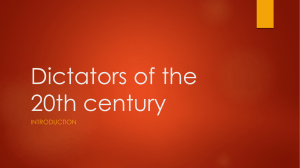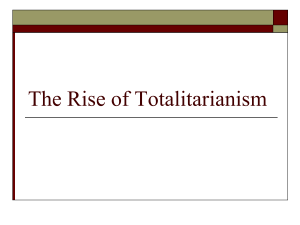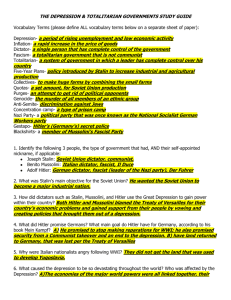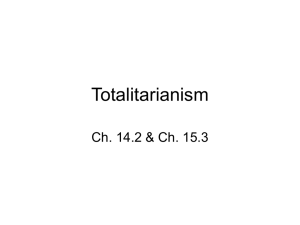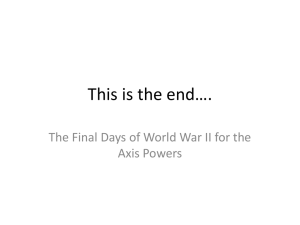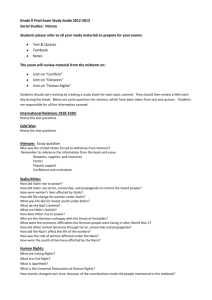WWII Intro - Geo Queen Bee
advertisement
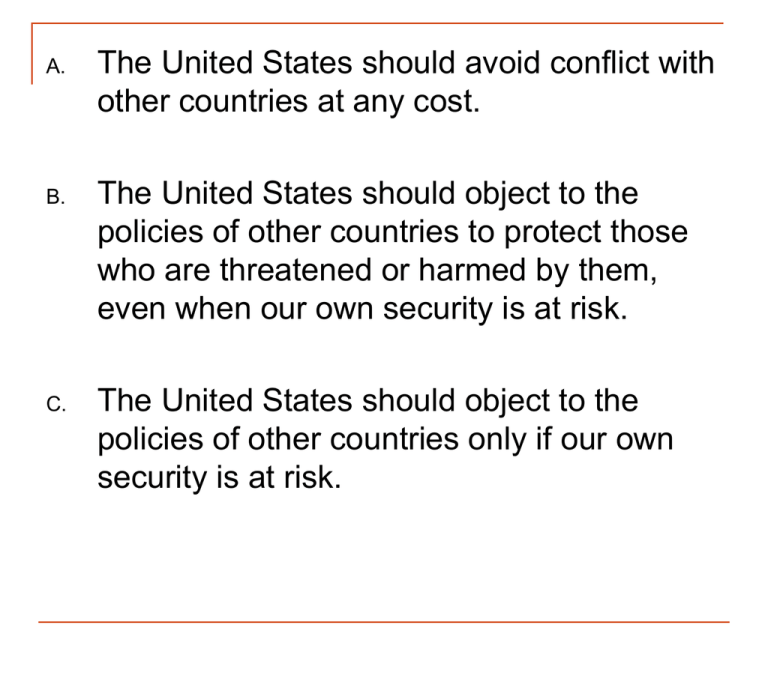
A. The United States should avoid conflict with other countries at any cost. B. The United States should object to the policies of other countries to protect those who are threatened or harmed by them, even when our own security is at risk. C. The United States should object to the policies of other countries only if our own security is at risk. The Coming of War 1931-1942 The Treaty of Versailles (1919) A Changed Europe A Changed Europe Dictatorship autocratic form of absolute rule leadership unrestricted by law, constitutions, or other social and political factors within the state. Totalitarianism Twentieth-century phenomenon A single party or leader controls the economic, social, and cultural lives of its people Characteristics of a totalitarian state Single-party dictatorship exerting control over all aspects of life Strong, charismatic leader often at head of government State control of the economy Use of police, spies, and terror to enforce the will of the state Government control the media and use of propaganda to indoctrinate citizens Use of schools and youth to spread ideology to citizens Strict censorship of artists, intellectuals, and political rivals with dissenting opinions In other words… Dictatorship source of the governing power where the power comes from Contrast to democracy Dictatorship: government without people's consent Democracy: government whose power comes from people Totalitarianism scope of the governing power what is the government Contrast to pluralism Totalitarianism: government controls every aspect of people's life Pluralism: government allows multiple lifestyles and opinions The Soviet Union Soviet Union 1917: Russian Communist Revolution First totalitarian state (Vladamir Lenin) 1924: Joseph Stalin becomes head of the state Joseph Stalin “Man of Steel” Transform the Soviet Union Suspicious, cruel, ruthless, tyrannical Industrial power State-run collective farms 10 million deaths Great Terror (1930s) Purge of the Communist Party Joseph Stalin A combination of fear and massive propaganda kept Stalin in power Italy Italy Totalitarianism—direct result of the war and the peace treaties Land Depression Communist movement Weak and inept government Benito Mussolini 1919: Fasci di Combattimento (Fascist Party) Right-wing organization Promotes nationalism Promised to make Italy great again “Black Shirts” Fought socialists and communists Benito Mussolini 1922: forms government “Il Duce” (“the leader”) Controlled government and army within a few years Outlaws political parties Controlled press Secret police Youth groups Suppressed strikes Opposed liberalism and socialism Benito Mussolini Never held the same power over Italy that Stalin held over the Soviet Union. Characteristics of a totalitarian state Single-party dictatorship exerting control over all aspects of life Strong, charismatic leader often at head of government State control of the economy Use of police, spies, and terror to enforce the will of the state Government control the media and use of propaganda to indoctrinate citizens Use of schools and youth to spread ideology to citizens Strict censorship of artists, intellectuals, and political rivals with dissenting opinions Germany Weimar Republic German democracy Struggled throughout the 1920s Establishing new government Economic problems Runaway inflation Resented the Treaty of Versailles Worldwide Great Depression The Nazis National Socialist German Workers’ Party Opposed socialism, communism German ethnic solidarity Adolph Hitler Joined the small Nazi Party after WWI Soon gained control Mein Kampf (“My Struggle”) Explained Germany’s troubles People, political programs, ideologies Communists and Jews Anti-Semitism in Europe Outlined hatreds, plans for world domination Adolph Hitler 1933: Hitler appointed chancellor of Germany 1934: Führer Complete control of state and military Unchecked by Reichstag Symbol of the totalitarian regime Secret police State-controlled press, education system Adolph Hitler Economic policies ended depression Rearmament Public works projects Political initiatives restricted freedom Jews Communists Socialists Propaganda against Jews Japan Japan 1920s: democracy Reduced military power All men have the right to vote Legalized trade unions Diverse political parties Japan Great Depression ended this period Increasing military power could solve economic problems Japan did not become a totalitarian dictatorship Constitutional monarchy Japan Aggressive military expansion 1931: Manchuria 1937: control over China Railroads, coastal areas “The Rape of Nanjing” 1930s: The Decade of Aggression “The best lack all conviction and the worst are full of passionate intensity.” William Butler Yeats 1930s: The Decade of Aggression League of Nations Only as strong as its members’ resolve Hitler Reunifying Germanic people under one Reich (state) Saar; Rhineland Mussolini 1935: Invasion of Ethiopia 1930s: The Decade of Aggression Spanish Civil War (1936-1939) Nationalists (fascists) rebelled against democratic Republican government Nationalists aided by Hitler and Mussolini Soviet Union aids Republicans France, Britain, U.S. remain uninvolved Appeasement Grants concessions to a potential enemy in the hope that it will maintain peace Li'l Hitler Austria—Anschluss Sudetenland (w. Czechoslovakia) Munich Pact: “peace for our time.” 11 months later… WHY DIDN’T BRITAIN STOP HITLER?
